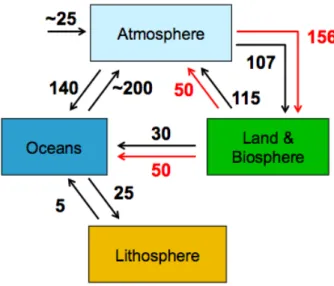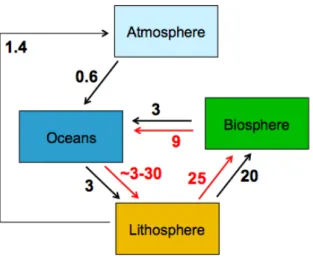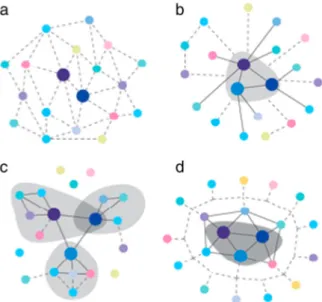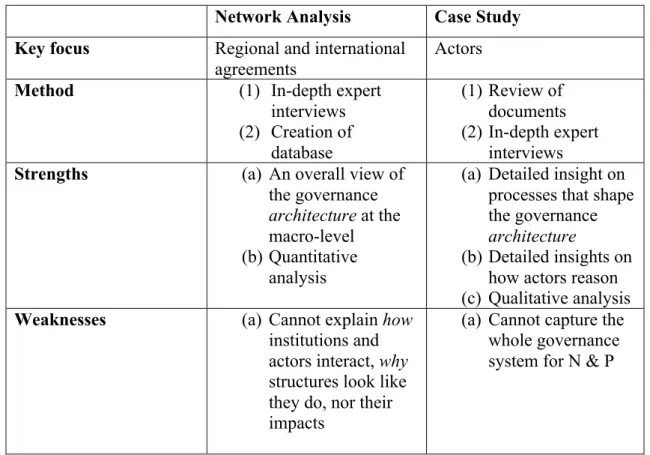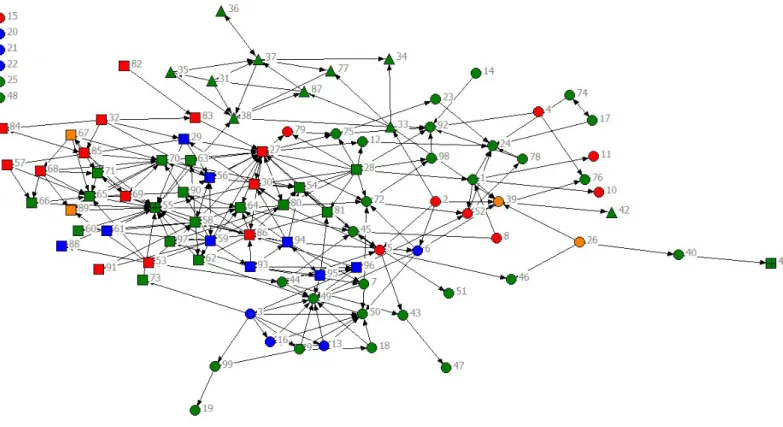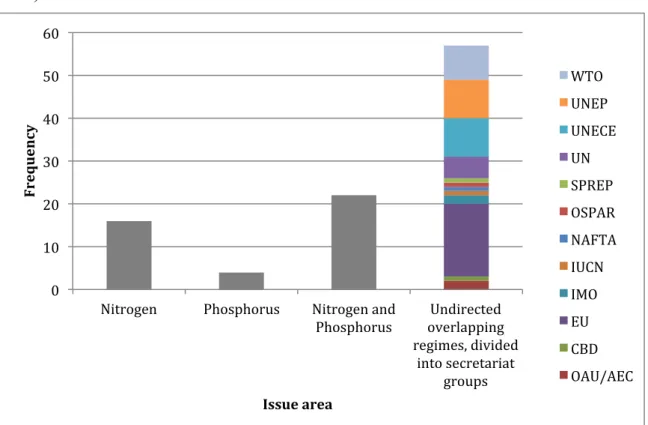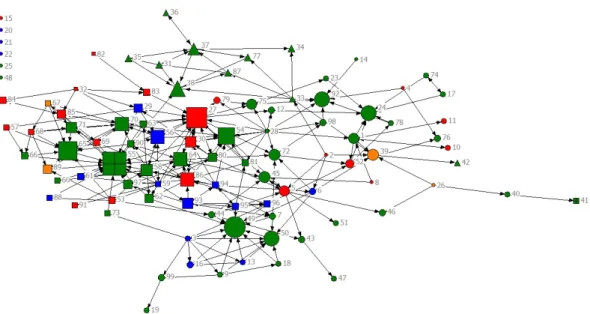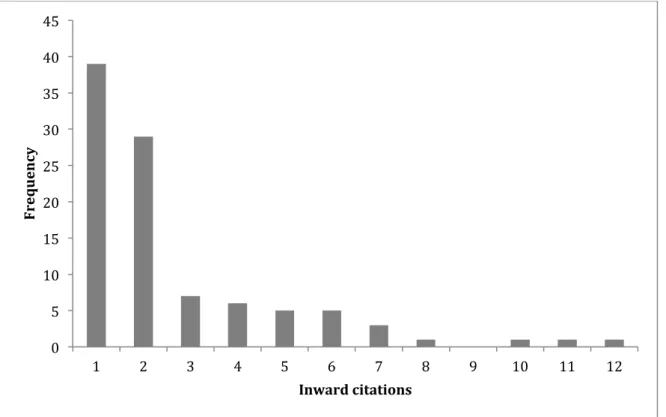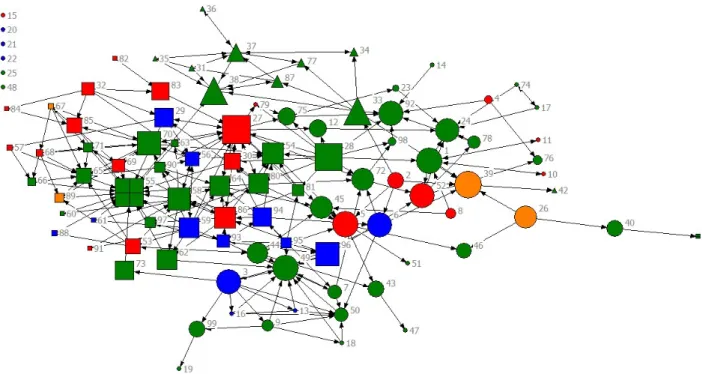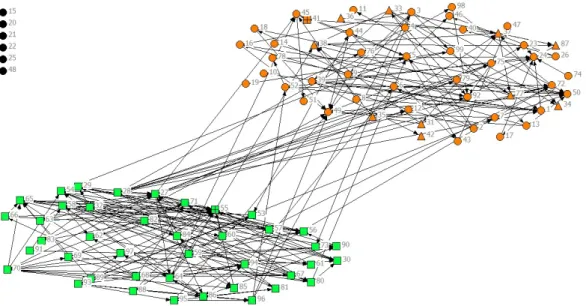Master’s Thesis, 60 ECTS
Social-ecological Resilience for Sustainable Development
Master’s programme 2013/15, 120 ECTS
Institutional structures and actor
collaborations for the governance of
global nitrogen and phosphorus cycles:
investigating polycentric order
Hanna Ahlström
Stockholm Resilience Centre
ACKNOWLEDGEMENTS: The topic of global governance of nitrogen and phosphorus cycles certainly sounds overambitious for a Master’s thesis. I am very grateful to my supervisors Dr Victor Galaz and Dr Rakhyun E. Kim who gave me the opportunity to try it out. Without your guidance, support and endless reading of my drafts it would have never been possible. A special thanks to Dr Sarah E. Cornell who has given me additional support and help. I would also like to express my appreciation to everyone who dedicated time and shared their views by participating in interviews. Thank you Professor Ole-Andreas Rognstad, Diego Galafassi, Andrew Merrie, Brita Bohman, Matilda Petersson, and Zuzana Harmáčková. Thank you Dr Tatyana Deryugina for being such an engaging teacher, sparking my interest in global environmental governance and international relations. Last but definitely not least, thanks to all my wonderful classmates because your support has been the most important.
Institutional structures and actor collaborations for the governance of global nitrogen and phosphorous cycles: investigating polycentric order
Hanna Ahlström
Supervisor: Dr Victor Galaz Co-supervisor: Dr Rakhyun E. Kim
Abstract: Despite an increased interest from the global change and resilience community, there is limited knowledge about the features and outcomes of polycentric governance. Moreover, there are few examples from the literature explaining transitions from lower to higher degrees of polycentric order. This seriously limits the explanatory power and application potential of the theory. The present study addresses this gap by investigating the global governance of nitrogen (N) and phosphorous (P) cycles. Those biophysical flows are two of the identified Earth-system processes in the “planetary boundaries” framework. This study explores governance challenges associated to these processes by analysing present institutional structures and actor collaborations. This is done by studying the network structures among all relevant multilateral agreements, EU (-level) Directives, and agreements on trade, combined with a more in-depth analysis of one global partnership initiative as a means to assess a possible emerging structure of polycentric order. The present study provides insights into how the current governance regimes in place for regulating the issues related to N and P flows look like, as well as issues and synergies of having a global partnership in place. The study suggests a global structure of polycentricity, which has the possibility to evolve into a better “match” with the dynamics of those biophysical flows through a larger governance context.
ABBREVIATIONS AND ACRONYMS
CBD Convention on Biological Diversity
EU European Union
FAO Food and Agriculture Organisation GEF Global Environment Fund
GPA Global Programme of Action for the Protection of the Marine Environment from Land-‐based Activities
GPNM Global Partnership on Nutrient Management
IMO International Maritime Organization INI International Nitrogen Initiative
IUCN International Union for Conservation of Nature
MEA Multilateral environmental agreement
N Nitrogen
NAFTA North American Free Trade Agreement
P Phosphorus
OAU/AEC Organization of African Unity/African Economic Community
OSPAR Oslo/Paris convention (for the Protection of the Marine Environment of the North-‐ East Atlantic)
SNA Social Network Analysis
SPREP Secretariat of the Pacific Regional Environment Programme
UN United Nations
UNCLOS United Nations Convention on the Law of the Sea
UNECE United Nations Economic Commission for Europe
UNEP United Nations Environment Programme UNFCCC United Nations Framework Convention on
Climate Change
Table of Content
1. Introduction ... 1
1.1.Why focus on global nitrogen (N) and phosphorous (P) cycles? ... 1
1.2 Aim and research questions ... 3
2. Global nitrogen and phosphorus flows ... 5
2.1 Anthropogenic disturbances of the N cycle ... 5
2.2 Anthropogenic disturbances of the P cycle ... 6
3. Theoretical background ... 7
3.1 Polycentric order and systems ... 7
3.1.1 Polycentric features and processes ... 7
3.2 A global institutional network ... 9
3.3 Architecture ... 10
4. Methods ... 11
4.1 Mixed-method approach ... 11
4.2 Network Analysis ... 12
4.2.1 Preparing the database ... 12
4.2.2 Creating the network ... 13
4.2.3 Network connectivity ... 14
4.2.4 Cross-level citations ... 16
4.3 Case Study preparations and in-depth interviews ... 17
5. Results ... 18
5.1 The citation network of global N and P governance ... 18
5.1.1 Inward and Outward citation connectivity ... 22
5.1.2 Betweenness centrality ... 25
5.1.3 Cross-scalar connectivity ... 26
5.2 The Global Partnership on Nutrient Management ... 27
5.2.1.The evolution of GPNM ... 27
5.2.2 The Birth of GPNM ... 28
5.2.3 Functioning of the GPNM in relation to current governance regimes ... 29
5.2.4 GPNM now and in the future ... 30
5.2.5 GPNM as facilitator of polycentric order ... 30
5.3 An emerging polycentric order for nitrogen and phosphorous ... 31
6. Discussion ... 32
6.1 The overall governance architecture for N and P ... 32
6.2 Polycentric transitions within the GPNM ... 34
6.3 Emergence ... 35
6.4 Planetary boundaries and polycentric governance ... 36
7. Conclusion ... 38
8. References ... 39
Appendix I. Global nitrogen and phosphorus flows ... 47
Appendix II. List of interviewees for pre-study ... 48
Appendix III. Table A. Criteria for the selection of agreements ... 49
Appendix IV. Detailed description of process of selecting agreements ... 50
Appendix VI. List of agreements ... 54 Appendix VII. Difference between European law and International law ... 84 Appendix VIII. Figure A. Cross-scale citation network with manually displaced nodes ... 85 Appendix IX. List of interviewees for Case Study (GPNM) ... 86
List of Figures
Figure 1. Global nitrogen cycle, and its flows between systems. ... 5
Figure 2. Global nitrogen cycle, its flows, and multiple chemical forms and states. .... 6
Figure 3. Global phosphorus flows through systems. ... 6
Figure 4. From "weak" to "strong" processes of polycentric order. ... 8
Figure 5. Schematic example of degree centrality. ... 15
Figure 6. Schematic example of betweenness centrality. ... 15
Figure 7. Visualisation of agreement connectivity network. ... 19
Figure 8. Distribution of the four different agreement categories for issue areas ... 20
Figure 9. Visualisation of agreement connectivity network using indegree centrality. ... 23
Figure 10. Visualisation of the agreement connectivity network using outdegree centrality. ... 23
Figure 11. The distribution of inward citations (i.e. indegree centrality) ... 24
Figure 12. The distribution of outward citations (i.e. outdegree centrality). ... 24
Figure 13. Visualisation of the agreement connectivity network using betweenness centrality ... 25
Figure 14. Cross-scale citation connectivity network ... 26
1. Introduction
There has been an increased interest in polycentric systems and order as a potential strategy to deal with complex global environmental problems (Galaz et al., 2012c; Ostrom, 2010). The reason for this is that polycentric systems may contribute to solve difficult collective-action problems, including the provision of diverse public goods and services (Ostrom, 2010). However, there is limited knowledge about their features and outcomes (Aligica & Tarko, 2011) as well as very few examples from the literature explaining transitions from lower to higher degrees of polycentric order (Galaz et al., 2012c). This is problematic because this limits the explanatory power and application potential of the theory. It is important to be able to distinguish between different degrees of polycentric order since it is not evident that polycentric order in general, to any degree is an effective strategy to deal with global environmental stresses. Furthermore, identifying the features that drive governance from one end of an actor sequence to another, also uncover key processes not only important from case to case, but for effective governance structure in general.
In this thesis, I intend to investigate the current governance structures in place for global nitrogen (N) and phosphorous (P) cycles as a means to uncover institutional and actor connectedness cross sectors and scales that could outline a polycentric order. This thesis will provide insights into how the current governance regimes in place for regulating the issues related to N and P flows look like, as well as issues and synergies of having a global partnership in place. The study also provides insights in what processes in relation to N and P that is somewhat governed, which are not, and at what scale. This is done as a means to improve understanding on how to create better governance “match” with the dynamics of these biophysical flows through a larger governance context.
1.1.Why focus on global nitrogen (N) and phosphorous (P) cycles?
Rockström et al. (2009) proposed nine Earth-system processes and associated thresholds that if crossed, could generate unacceptable environmental change. Global N and P cycles are two of those identified Earth-system processes. Steffen et al.
The ability to determine the temporal and spatial distribution of environmental effects is limited (Steffen et al., 2004). This translates to a major challenge for governance since current governance and management paradigms often do not take into account, or lack a mandate to act upon these complex interacting planetary risks (Walker et al. 2009).
Research on “planetary boundaries” with a focus on governance in relation to N and P is not a well-investigated area, and there are only few examples from the literature. One example is de Vries et al. (2013), which describe the governance interest in, and criticism of “planetary boundaries”, specifically with respect to the nitrogen N cycle. Ebbesson (2014) also explores the issue from a legal point of view.
The case of global governance of N and P flows is a suitable case to further address the gap of knowledge about transitions from lower to higher degrees of polycentric order, here referred to as “polycentric transitions” since the anthropogenic influence of these flows are not well governed. Hence, the main assumption is here that there are very weak, unconnected governance structures in place. This assumption was made with regard to the limited extent of progress to date, which highlights the substantial barriers to change for the nutrient issues that are described by for example Sutton et al. (2013). One big issue is that there is no international legal framework intended to deal with eutrophication only, even though United Nations Convention on the Law of the Sea (UNCLOS) as well as some regional seas conventions applies to marine pollution through N and P (Ebbesson, 2014).
The assumed lack of enforceable international governance structure in place at the global scale makes it interesting to study possible structures in place, or structures that are emerging. Therefore, the current governance regimes and their structures can reveal some important conclusions about the current official state of governance. A governance regime is here defined by Krasner (1983) as in a set of explicit principles, norms, rules, and decision-making procedures around which actor expectations converge in a given area of international relations and which may help to coordinate their behaviour.
1.2 Aim and research questions
The aim of the present study is to analyse institutional structures and actor collaborations for the governance of global nitrogen and phosphorous cycles for the purpose of investigating polycentric order.
The main research question (Q1) for this project is ‘Is polycentric order emerging
among relevant institutions and actors that are associated with global nitrogen and phosphorous cycles?’
To elaborate this, I ask and respond to two sub questions:
Q1.1: Is there a network structure amongst institutions emerging at the international level facilitating cross-sectoral and cross-scalar collaboration?
Q1.2: Are there any global partnership initiatives that are important for the governance of global N and P cycles?
Q1.1 will elaborate on how global institutions emerge and form governance structures, an issue often captured under the term “architecture” as defined by Biermann et al. (2009a, p. 15, 2009b) as “the overarching system of public and private institutions that are valid or active in a given issue area of world politics”. A focus on polycentric order entails a focus beyond single institutions, meaning to rather look at multiple social entities, as well as cross-level interactions, which implies that the notion of governance architecture becomes relevant. The concept of architecture (2009a, p. 15, 2009b) here allows for the comparative analysis of issue areas and policy domains, and for the study of overarching phenomena that the more restricted concept of regimes could not capture. Q1.2 will complement the focus on formal institutions, and instead explore collaborations patterns at the international level with a focus on actors.
My approach to governance analysis is both analytical and normative. In this case it means I use the term “global governance” for denoting observable phenomena and the corresponding perspective on those phenomena (Dingwerth and Pattberg 2006) meanwhile acknowledging that there is currently a limited understanding of societies’
to bring out network structures and possible functionality. In summary, this study is an attempt to illustrate that there are interesting benefits from integrating polycentric theory with network theory.
2. Global nitrogen and phosphorus flows
Figure 1, 2, and 3 provides the analytical point of departure, since those figures clearly illustrates the interplay from an Earth systems perspective. The figures show key processes that are the most prominent ones with regard to environmental effects. Those figures and information from key informants (Appendix VI) has been used as basis for developing the sets of criteria for selection of agreements in Appendix II.
2.1 Anthropogenic disturbances of the N cycle
The main human alteration of N fluxes is the conversion of non-reactive N in the atmosphere to reactive forms (both oxidised and reduced forms), and their application to the land surface (Steffen et al., 2004). Humans create reactive nitrogen (Nr) in three ways: through cultivation, industrial fixation of elemental nitrogen (N2) to ammonia
(NH3), and fossil organic N to nitrogen oxide (NOx) in which the industrial reduction
for the creation of fertiliser is the most important one (Steffen et al., 2004).
Figure 1. Global nitrogen cycle. The figure describes the N flow between systems. Red arrows show main human-‐caused flows. Units are Tg N yr1 = million tonne N yr1. The figure is adapted by Cornell
Figure 2. Global nitrogen cycle. The figure describes the N flow and N in its multiple chemical forms and states. The figure is adapted by Cornell (2015) based on Ward (2012).
2.2 Anthropogenic disturbances of the P cycle
The human perturbation of the P cycle is the mining of finite phosphate rock deposits, their conversion to fertilisers or detergents, and their application to terrestrial-based systems (Steffen et al., 2004). The major response is (i) enhanced growth of terrestrial biota due to the use of fertilisers, (ii) leakage of applied P into rivers and eventually to the coastal zone and surface waters, and (iii) enhanced growth of marine biota (Steffen et al., 2004).
Figure 3. Global phosphorus flows through systems. Units are Tg P yr-1 = million tonne P yr-1. The
figure is adapted by Cornell (2015) based on data from Sutton et al. (2013) and Filippelli (2002).
3. Theoretical background
3.1 Polycentric order and systems
The theoretical starting point for this study is that political structures in relation to public organisations include problems of scale (Ostrom et al., 1961, p.831), which supports exploration of cross-scalar structural patterns among institutions and actors. The present study defines “polycentric systems and order” as “many centres of decision making that are formally independent of each other” as outlined by Ostrom et al., (1961). This definition is considered as one of the most established ones (see Ostrom, 2000; Ostrom, 2010; Ostrom et al., 1961). The present study investigates both institutional structures, as well as actor collaborations. This means that very different, “formally independent” social entities rather than just governing authorities are investigated. This justifies the use of the definition outlined by Ostrom et al. (1961).
According to Aligica & Tarko (2011) using polycentricity as a framework could help draw non-ad hoc analogies between different forms of self-organizing complex social systems as well as challenge and strengthen institutional imagination. Different evolving climate governance structures of polycentric order have been suggested (Andonova, 2009; Ostrom, 2010) and further recognized in various forms by, for example, Galaz et al. (2012c) and Kim (2012).
3.1.1 Polycentric features and processes
Toonen (2010) highlight that polycentric systems tend to enhance innovation, learning, adaptation, trustworthiness, and levels of cooperation of participants. Galaz et al. (2012c) propose that there exist four generic processes in polycentric systems at the international level. As described in Figure 4, these processes include information
sharing and mutual adjustment (probably the weakest form of polycentric order at the
international level), coordination of activities (a stronger version of polycentric order and requires a larger investment in formal partnerships, joint projects and experiments), and problem solving and conflict resolution (likely to be the strongest). Those kinds of transitions are described by Ostrom in McGinnis (1999, p.56) as “polycentricity in the structure of governmental arrangements; economic affairs;
constitutional rule”. The present study is trying to assess some of these attributes and processes by analysing actor collaborations as a means to improving the understanding of multi-level governance process better.
Figure 4. From "weak" to "strong" processes of polycentric coordination and order. The figure illustrates (a) a simple communication network that allows for mutual adjustment (b) a stronger from of coordination as it combines communication linkages, with formal partnerships arrangements. (c) a stronger form of polycentricity involving tangible joint projects/experiments (d) is the strongest from of polycentric order, and involves strong formal ties between key actors, joint projects and the evolution of rules. (Galaz et al., 2012c).
The current incomplete knowledge about the features and outcomes of polycentric systems (Aligica & Tarko, 2011) pose serious implications to the application of the theory. This study is an attempt to improve the explanatory power and application potential of the theory using the case of governance structures in place for N and P. The more specific challenge for applying the theory is the limited knowledge about transitions from lower to higher degrees of polycentric order (Galaz et al., 2012c) as mentioned in the outset. When distinguishing between different degrees of polycentric order, the extent to which the structures outline an effective strategy to deal with global environmental stresses can be revealed. The needs of identifying the features that drive governance from one end of the actor sequence to another (see Galaz et al., 2012c) also uncover key processes. The bulk of the polycentricity literature has used case studies such as certain common pool resources (e.g. Kloosterman and Lambregts, 2001; Wade, 1994). Identifying processes that are not only important from case to case, but for effective governance structures in general is therefore
another current important limitation of the theory.
3.2 A global institutional network
While the attributes and processes that are denoted as polycentric features by Galaz et al. (2012c), might be accurate for cases where actors interact, it may not be as evident when investigating the relationship between formal institutions such as multilateral agreements. Relationships among social entities such as treaties can however be analysed using social network analysis (Wassermann & Faust, 1994) even though a significant part of the literature has studied ‘actors’. A network approach allows the use of a precise formal definition for aspects of the political, economic, or social structural environment. This approach also enables to reveal important links between agreements, which could be useful for both analytical and practical (e.g. policy) purposes. Network structures among institutions such as MEAs can be considered to outline structured maze that in turn has a potential to consist of polycentric patterns (Kim, 2013). One of the best arguments describing that proposition is that MEAs have multi-level and multi-topic features: they vary to a significant degree in terms of subject matter, objectives, memberships, geographical scope, regulatory mechanisms, and underlying jurisprudence (Kim, 2013).
In the present study, different regional and international agreements have been viewed through a network approach even though agreements are not actors, but documents. The reason is that these instruments are at the same time often dynamic in the sense that they evolve through amendments, reinterpretation etc., through actor collaboration such as the Conferences of the Parties, and in international organizations. It will therefore be argued that the selected agreements are to some extent "actors on their own”, or acting like legally independent organizations with ‘‘autonomous institutional arrangements’’ (see Churchill and Ulfstein, 2000; Ulfstein, 2012, Kim and Mackey, 2014).
By creating a network, the social environment can be expressed as patterns of regularities in relationships among interacting units, which more easily could be referred to as structures (Wasserman & Faust, 1994). This approach has recently emerged as a toolkit in the analysis of complex systems (Amaral and Ottino, 2004;
the whole system, despite its size. Without the use of a method such as social network analysis (SNA) it is near impossible to analyse institutional complexity of a global system such as the governance regimes in place for N and P management since the system is very large and has a great variety of scope. Another key benefit with this approach is the power of visualising these institutional elements through a network, which ensures that the size and complexity of the system is seen.
3.3 Architecture
Institutional analyses of effectiveness and relationship between certain institutions or institutional elements are common (e.g. Biermann, 2008; Young, 2011) but the overall architecture at the macro-level has remained largely outside the focus of most previous studies (Biermann, 2007). There are few examples of attempts to map out the overall architecture of institutional elements, such as the study by Kim (2013). While case studies (see 3.1.1) and analyses of governance architecture normally are used separately, the present study attempts to combine them as a means to encapsulate the scale of the global environmental problems related to the anthropogenic disturbances of the N and P cycles. The approach is slightly different from the large and acknowledged body of literature on institutional interactions, here defined by Oberthür and Stokke (2011, p.4) as “…one institution affects the development of or performance of another institution”.
A focus on the overall governance “architecture” also means to reveal what the overall current structure is not doing in terms of governance, meaning where and in what sense the network of regional and international agreements is a base for regulatory outcome. This means to reveal whether there is a “gap in governance” and possible responses to this gap. An analysis of this kind becomes interesting in conjunction with the emergence of a global partnership initiative, since it makes sense to consider all relevant actors mobilising different initiatives that may have an influence on governance outcomes and possibly having an impact on governance “fit”.
4. Methods
The analysis is structured through two-steps: (a) an analysis of institutional structures through a network analysis, and (b) a study of the global partnership initiative Global
Partnership on Nutrient Management (GPNM). It is to be noted, however, that
combinations of quantitative (network analysis) and qualitative methods (in-depth expert interviews) were used in conjunction to work out network structures in the institutional landscape.
4.1 Mixed-method approach
Methodologically I did not study these two sections using the same methods. It would be conceptually possible to include both all regional and international agreements and actors involved in the partnership using only SNA (e.g. creating a 2-mode network). However, that would not necessarily provide comprehensive information as to why structures look like they do, or activities taking place between individual agreements or actors. It is important to critically review what a quantitative approach actually says about the governance structure in the context of coordination and institutional fit. An overall view of the governance architecture at the macro-level cannot show activities taking place around organisations and conventions that are being influenced by certain actors. A partnership has a limited amount of actors, which means that its structures can be perceived through the use of qualitative analysis. This can provide additional information about the function or effects of the identified network of agreements. The arguments for choosing a mix-method approach are summarised in Table 1.
Table 1. Summarised arguments for a mixed-method approach.
Network Analysis Case Study
Key focus Regional and international
agreements
Actors
Method (1) In-depth expert
interviews (2) Creation of database (1) Review of documents (2) In-depth expert interviews
Strengths (a) An overall view of
the governance
architecture at the
macro-level (b) Quantitative
analysis
(a) Detailed insight on processes that shape the governance
architecture
(b) Detailed insights on how actors reason (c) Qualitative analysis
Weaknesses (a) Cannot explain how
institutions and actors interact, why structures look like they do, nor their impacts
(a) Cannot capture the whole governance system for N & P
4.2 Network Analysis
The analysis was enabled using the approach developed by Kim (2013) and consisted of three steps: (i) dataset compilation, (ii) network analysis, and (iii) visualisation of network data.
4.2.1 Preparing the database
As a first step, interviews were conducted with nine strategically selected subjects having insights into the institutional design, multilateral negotiations, and the science of global N and P flows (appendix list II of interviewees). The subjects were selected due to their acknowledged expertise (S. E. Cornell, personal communication, September 15-26, 2014) together with snow-ball sampling; each interviewee was asked to recommend someone people suitable for an interview as a way to confirm that the sampling included representative individuals (Arber, 2001). This was done in order to have a starting point for collecting information about the existing governance architecture, and to make sure that important information was not missed.
The nodes included in the database are multilateral environmental agreements (MEAs), EU (-level) Directives, and international agreements on trade among other appropriate regional and international agreements relevant for the governance of N and P cycles (see Appendix VI and list of agreements). In order to be as objective and comprehensive as possible when building the dataset, the database was created through a couple of different strategies. As part of this aim the purpose here was to include all relevant protocols associated with identified conventions in order to be able to include all possible scales and relevant information. This also means that each instrument is considered as “legally autonomous”. The process of selecting agreements were: (1) reviewing the International Environmental Agreements Database project developed by Mitchell (2002-2014), and the ECOLEX database (IUCN et al., 2014), (2) using data from interviews, (3) including trade agreements on the basis that governance architecture can be conflictive (see Biermann, 2014, p. 85-86), (4) to look for agreements that implicitly deal with pollution of N and P, and (5) to use key words for different kinds of agreements and make searches in each legal document. For a detailed review on the process and deficiency of my selection of agreements see Appendix IV and V.
4.2.2 Creating the network
A network was created through the use of citations and cross-referencing that represents proxies for links between agreements (see Kim, 2013). MEAs have often included cross-references to a number of agreements considered relevant by the parties (Kim, 2013). Cross-referencing can be viewed as extending the legal effect of cited texts to the texts citing them (Kiss and Shelton, 2007). The reason is that the cross-reference is referring to other legal texts with legal importance, which is seen relevant to build upon. This type of cross-reference usually appears in the preamble where the parties to the agreed agreement are, for example, ‘noting’, ‘recalling’, ‘reaffirming’, ‘recognizing’, ‘bearing in mind’, or ‘taking into account’ relevant agreements (Kim, 2013).
All links have been identified manually through making searches in each legal document, looking for (a) references to agreements that were collected as a result of the first strategy of finding agreements that already been included in the database, but
references also enabled an extension of the database meanwhile creating additional links in the network.
4.2.3 Network connectivity
The network data were visualised using the network analysis computer programme NetDraw available through the software programme Ucinet (see Borgatti et al., 2002). I used NetDraw to create graphical representations of the system. A basic analysis of the topological properties was performed as a means to be able to draw conclusions from the architecture outlined by the institutional landscape.
Hubs of nodes (separated subgroups of nodes) that are more connected compared to other nodes in the network were identified. It should be noted that those hubs in the present study represent different governance regimes. This part of the analysis makes it possible to draw conclusions on which regional and international agreements are the most connected, and potentially the most important ones, in terms of affecting regulatory – and governance outcome. I will explore the issue further below.
Firstly, the network measure degree centrality was used to measure the importance of an agreement. To calculate this measure citations from other nodes are added up (so called “inward citations”, for examples of legal cases see Fowler et al., 2007). The simplest definition of this measure is that “the central actors must be the ones that are the most active” in the sense that they have the most links to other actors in the network (Wasserman and Faust, 1994). Prior studies of law have been using degree centrality as a way to measure the continuing relevance or importance of a given case or judge (see Landes and Posner, 1976; Kosma, 1998; Hansford and Spriggs, 2006).
Figure 5. Schematic example of degree centrality, adapted from Wasserman & Faust (1994).
Secondly, the measure betweeness centrality was used since it is another metric that measures the importance of an agreement. The importance is being measured through the calculation of the geodesics (i.e. the shortest path between two nodes, see definition by Wasserman and Faust, 1994, p. 110). Essentially: this calculation can uncover what nodes are most central in relation to the other nodes in the network. It means that nodes with high betweenness centrality are connected indirectly to many of the nodes via their links (see explanation of actor betweenness centrality in Wasserman and Faust, 1994). An agreement could therefore have control over other agreements because of the relevance and how it is being cited. An example of this could be an international institution having an effect on supplemental jurisdiction at a lower scale. Volbeda (2006) exemplifies this using the case of international environmental claims under UNCLOS. If the level of betweenness centrality “matches” a real process of supplemental jurisdiction, that would represent interesting application possibilities on real life processes.
It should be carefully noted that there are some limitations with regard to what citation networks can show. A citation network has directed links, which show one-way flow of information or influence from node A to node B. A citation does not say anything about (or presume the existence of) the potential flow of information/influence in the opposite direction from node B to node A. Betweeness
centrality presumes that the network is non-directional, i.e. that there are flows in
both directions. The use of the measure betweenness centrality is still sensible in the present analysis however since it is assumed that information flows in both directions in reality. This assumption is based on the fact that information often flows in both directions, and an example is that the Convention on Biological Diversity (CBD) is citing the UNCLOS, which was adopted before CBD. However, that does not necessarily mean UNCLOS does not interact with CBD in practice. This interplay is acknowledged and discussed in detail by Wolfrum and Matz (2000).
4.2.4 Cross-level citations
Degree centrality and betweenness centrality measures were calculated as a means to
draw some conclusions in line with the proposition made by (Kim, 2013) namely that MEAs could outline a polycentric system since they vary to a significant degree in terms of subject matter, objectives, memberships, geographical scope, regulatory mechanisms, and underlying jurisprudence. The approach chosen here was to not only look at different subject matters, but also include a focus on cross-level citations, which are links between agreements (nodes) that are situated at different governance scales. These links are important because cross-scalar structures have a potential to outline polycentric order. Another reason for having this focus is the potential to explore interesting regulatory dynamics and legal interactions between MEAs and EU (-level) Directives, such as which EU (-level) Directives possibly acting as “gateways” (a channel or medium here used as a term for defining an agreement that is either citing or being cited by, agreements representing another geographical scale) to the international regimes.
4.3 Case Study preparations and in-depth interviews
The Global Partnership on Nutrient Management (GPNM) is acknowledged to be successful in gathering multiple actors and establish certain projects among nutrient scientists (de Vries and Cornell, personal communication, January 7-February 25). Additional interviews were conducted with nine strategically selected subjects using official documents from the GPNM, together with snow-ball sampling (see Arber, 2001). All interview subjects have had, or have active involvement in the GPNM (see appendix list IX of interviewees). The focus was on identifying information about the GPNM as a means to complement the analysis of formal regional and international agreements. The interview questions were designed differently depending on the interviewees’ expertise but in general they captured (a) milestones (b) each organization's missions and goals, (c) organization’s motivations for joining the partnership initiative, (d) the goals over time, (e) functioning in comparison to current governance regimes, (f) strategies for influencing policies and to keep the initiative going, (g) challenges, and (h) opportunities associated with the partnership.
This section was developed in order to answer the main research question, with a focus on the second sub question. The data from the interviews brought results that show interactions among actors, which were also used as to reveal certain institutional structures. This section answers the second research question since gathering information about actors involved in a partnership initiative carries the potential to provide information about whether or not this initiative is playing an important role in addition to the different governance regimes in place.
As suggested at the outset, this is interesting since an analysis of actor formation provides comprehensive information on why (the view of) the governance
architecture at the macro-level looks like it does, and whether a polycentric order is
emerging. This analysis focuses on the role and the functioning of the GPNM, which meant some relevant information about the network of agreements, and therefore the overall governance architecture important to the management of N and P flows. It also makes sense to include this section due to the acknowledged limitations to a citation network. Without this information the analysis would only consist of a merely static and fragmented collection of lifeless documents.
5. Results
The result section is structured in the same order as the applied methods, which means that (a) a quantitative network analysis of institutional structures, and (b) results about the global partnership initiative GPNM using qualitative analysis (in-depth expert interviews) are presented below.
In summary the findings from the present study are that a polycentric order is indeed emerging among relevant institutions and actors, which are associated with global nitrogen and phosphorous cycles. A network structure amongst institutions is identified to emerge at the international level that is to some extent facilitating cross-sectoral and cross-scalar collaboration even though the exact process of emergence is not demonstrated. Moreover, a global partnership initiative that is important for the governance of global N and P cycles has been identified.
5.1 The citation network of global N and P governance
The creation of a network map of institutions makes it possible to assess topological properties. As seen in Figure 7, the network is the result of mapping all identified regional and international agreements in place, that regulate activities that influence or create the anthropogenic perturbations of N and P flows directly and indirectly. In the figure, circles illustrate MEAs, squares illustrate EU (-level) Directives, triangles illustrate trade agreements, and boxes illustrate other relevant regional and international agreement. However, none of the circles represent an MEA with global coverage together with a specific focus on N or P. This is not explicitly shown in the network due to software limitation, but it is clear from Appendix VI when going through which agreements that are included in the database. On the contrary, regional agreements such as the 1979 Geneva Convention on Long-Range Transboundary Air Pollution (node nr 49) which has the regional coverage from United Nations Commission for Europe (UNECE), which according to Ebbesson (2014) been given priority to eutrophication (i.e. green circle nr 92). It is also seen in the figure that there are regional EU (-level) Directives that have specific focus on N and P. It is to be noted, however, that they differ in terms of structure, coordination, mandate, as well as compliance mechanisms in comparison to international law becomes particularly
Figure 7. Visualisation of agreement connectivity network. The nodes have been classified with colour attributes depending on issue area/objective and shape depending on agreement type. Node colour classes are blue = N, orange = P, red = N&P, and green = other relevant factor. Node shape classes are MEA = circle, EU-level directive/regulation = square, triangle = trade, and box = other relevant regional or international agreement. The nodes in the upper left corner are “islands”, i.e. unconnected nodes, which means agreements without citation links. Node number denotes the number of the agreement in the database.
As indicated by its title, the 1999 Protocol to Abate Acidification, Eutrophication and Ground-level Ozone, often referred to as the Gothenburg Protocol (node nr 3) also applies to nitrogen emission through the atmosphere. If this protocol is complied with, it should result in a reduced introduction of nitrogen in near sea areas since sets out, inter alia, national emission caps for nitrogen oxides and ammonia (see Ebbesson, 2014).
Figure 8. Distribution of the four different agreement categories for issue areas (node colour classes) in which node colour class 4 (green) is divided into secretariat groups as to uncover the different regimes part of the hub “undirected overlapping regimes”. See Appendix III and the set of criteria that was used to categorise the agreements, as well as and Appendix IV for the selection of agreements.
Figure 8 illustrate the frequency and distribution of instruments regulating the issues around N and P directly and indirectly. The network consist of a significant portion of agreements regulating the N and P issue indirectly (the column named Undirected
overlapping regimes, divided into secretariat groups), but has through the use of the
sets of criteria been selected due to their relevance. This column shows the clear diversity of regimes having an impact on N and P flows. However, the significant low amount of instruments that regulate the different issues concerning N and P directly, and the absence of an instrument with a global coverage reveal a gap in governance. This also draws attention to the chosen approach of the present study; the overall governance architecture, which not only supports the strategy to analyse institutional
0 10 20 30 40 50 60
Nitrogen Phosphorus Nitrogen and
Phosphorus overlapping Undirected regimes, divided into secretariat groups Fre que n cy Issue area WTO UNEP UNECE UN SPREP OSPAR NAFTA IUCN IMO EU CBD OAU/AEC
structures and actor collaborations, but all interesting social entities that have a direct, and an indirect effect on governance outcome. This means that the WTO agreement system, the EU (-level) Directives system, and the system of MEAs are clearly connected in a network. To the best of my knowledge, this interplay has not been studied before.
I used the topological measures degree centrality and betweenness centrality since they provide insights about the most central, and most important agreements in terms of referencing. Furthermore, those metrics also provided interesting insight about the network’s cross-scalar connectivity. This is shown in Figure 9, 10 and 13. However, the intention has not been to include an analysis of how the functioning of the system depends on its topological properties. It is here rather argued that it is useful to look into a real world example on how a citation connection in the network looks like from the point of view of how the legal text is being formulated and carried out. An interesting example is EU Water Framework Directive (node nr 27) since it is shown in section 5.1.1-3 that this directive is acting as an interesting node in the network. Node nr 27 is referring to the Convention on the Protection of the Marine Environment of the Baltic Sea Area, (node nr 12), the Convention for the Protection of the Marine Environment of the North-East Atlantic, (node nr 72), and the Protocol for the Protection of the Mediterranean Sea Against Pollution from Land-Based Sources to the Convention for the Protection of the Mediterranean Sea Against Pollution (node nr 79). The Directive is referring to these agreements as important, but that is slightly different to the following text that is also found:
“This Directive is to contribute to the implementation of Community obligations under international conventions on water protection and management, notably the United Nations Convention on the protection and use of transboundary water courses and international lakes, approved by Council Decision 95/308/EC(1) and any succeeding agreements on its application.”
The above citation show that the link between node nr 27 and nr 45 is an important link in reality, justifying the use of such an abstract representation as a network.
5.1.1 Inward and Outward citation connectivity
When interpreting Figure 9 and 10 it has been crucial to what features the most central agreements in the network have. For example, the Treaty on the Functioning
of the European Union (node nr 55) is a very connected node in a sense that it has a
high level of indegree centrality (inward citations). As by simple logic this agreement does not play a key role in global governance architecture for N and P, which mean that the use of the degree centrality measure needs to be assessed in conjunction with additional information about the nodes.
Thus, what is even more interesting is where the links go. That means that analysing the in- and outdegree centrality measure, will require looking at density of links, as well as links between hubs as a means to reveal cross-sectoral and cross-scalar linkages. One interesting case is the United Nations Convention on the Law of the Sea (node nr 92) as viewed in Figure 9, which clearly has cross-scalar links, as well as cross-sectoral links in the sense that this agreement is being cited mainly by MEAs, but also by the EU regulatory instruments and the WTO agreements.
Even though it is more interesting to look into where the links go, figure 11 and 12 shows the skewed distribution of links in the network, in which I suggest show an existence of hubs in the network. However, the chosen approach of including the “undirected overlapping regimes” that are being represented by green nodes in figure 9 and 10 result in more inward-and outward citations occurring in the network, which is here suggested to act as important institutions connecting the network.
Figure 9. Visualisation of agreement connectivity network using indegree centrality. The size of the nodes indicates the indegree centrality (the larger node the higher indegree centrality meaning the number of citations received).
Figure 10. Visualisation of agreement connectivity network using outdegree centrality. The size of the nodes indicates the outdegree centrality (the larger node the higher outdegree centrality meaning the degree of outward citation).
Figure 11. The distribution of inward citations (i.e. indegree centrality). The histogram shows the skewed distribution of links, which indicates the density of nodes in the network.
Figure 12. The distribution of outward citations (i.e. outdegree centrality). The histogram shows the
skewed distribution of links, which indicates the density of nodes in the network.
0 5 10 15 20 25 30 35 40 45 1 2 3 4 5 6 7 8 9 10 11 12 Fre que n cy Inward citations 0 5 10 15 20 25 30 35 40 45 50 1 2 3 4 5 6 7 8 9 10 11 12 13 Fre que n cy Outward citations
5.1.2 Betweenness centrality
When interpret the betweenness centrality in figure 13, it has also been important to analyse the features of certain agreements. For example, node number nr 27 (EU Water Framework Directive), plays a clear role in terms of acting as a possible “gateway”. This agreement lies on the paths between other nodes, which is creating a central position “between” other nodes, but more interestingly of the hubs of European legislation and International legislation. Other nodes that are having positions “between” many other nodes is the 1979 Convention on Long-Range Transboundary Air Pollution (node nr 49), and the Marine Strategy Framework Directive (node nr 28). This means that these instruments have a role to play in terms of connecting the different level of legislation (the hubs). This result answers the question whether there is emerging a polycentric order, since this supports the view that the network of agreements has self-organized into a more polycentric arrangement of governance.
Figure 13. Visualisation of the agreement connectivity network using betweenness centrality. The size of the nodes indicates the betweenness centrality (the larger node the higher betweenness centrality). The largest red node (nr 27) in the middle represents the EU Water Framework Directive, and the green largest node (nr 28) represent the Marine Strategy Framework Directive.
5.1.3 Cross-scalar connectivity
The examples on cross-sectoral and cross-scalar linkages using degree centrality and
betweenness centrality (Figure 9,10, and 13) in relation to the two-level visualisation
image (Figure 14) outline patterns that represent emerging polycentric order. What is clear is that the EU-level regime outline a dominant hub within the global network, and that the EU Water Framework Directive (node nr 27) and Marine Strategy Framework Directive (node nr 28), and Directive 2001/81/EC on national emission ceilings for certain atmospheric pollutants (node nr 96) act as “gateways” to international law. Even more interesting is possible role of the 1979 Geneva Convention on Long-Range Transboundary Air Pollution (node nr 49), since it is an agreement that is citing and being cited by, across these identified hubs.
When interpreting the functioning of those “gateway” agreements, I suggest that this could represent a diffusion processes in the emergence of law between European legislation and international law. Twining (2005) define diffusion of law as a “the processes by which legal orders and traditions are influenced by other legal orders and traditions”. It is a widespread aspect of interlegality and it is considered by some leading scholars to be a central aspect of comparative law (Twining, 2005), which therefore seems like an interesting finding from a larger governance perspective.
Figure 14. Cross-scale citation connectivity network. The cluster of nodes to the left represent EU (-level) Directives and the cluster of nodes to the right represent different regional and international agreements. Certain nodes such as number 27, 28, 49, 92 and 96 are suggested to act as “gateways” since they are connected across the legal levels of European environmental law and international environmental law. See Appendix VIII and Figure A to view specific nodes that have manually been displaced into the mid-section of the network as to highlight their cross-scalar connectedness.
5.2 The Global Partnership on Nutrient Management
As been presented in section 4, it is important to critically review what a quantitative approach actually says about the governance structure in the context of coordination and institutional fit. An overall view of the governance architecture at the macro-level cannot show activities taking place around organisations and conventions that are being influenced by certain actors. The acknowledged limitations with a citation network means it is useful to complement this analysis through a focus on how actors organised themselves in this larger governance context, which in this case means a formation of a global partnership. Code in parenthesis after each quote denotes interviewee code.
GPNM was established at the meeting of the UN Commission on Sustainable Development in 2009, which dealt with sustainable agriculture. The government of the US, the Netherlands and United Nations Environment Programme (UNEP) and Global Programme of Action for the Protection of the Marine Environment from Land-based Activities (GPA) founded GPNM as multi-stakeholder partnership. It has been launched to address the challenge of promoting effective nutrient management, minimising negative impacts on the environment and human health, while maximising their contribution to global sustainable development and poverty reduction. The GPNM is a global partnership of governments, scientists, policy makers, private sector, non-governmental organisations and international organisations. The partnership recognised the need for strategic advocacy and co-operation at the global level in order to communicate and trigger productive discussions not only regarding the complexity of the nutrient challenge but also the opportunities for cost effective policy and investment interventions by countries (nutrientchallenge.org).
5.2.1.The evolution of GPNM
The GPNM was established due to a recognised need for special attention to pollution from land-based sources to the seas and oceans, especially nutrient run-off and leaching to estuaries. It was acknowledged that there are nutrient issues, which are broader than only nitrogen and a need to also focus on phosphorus. UNEP had a program working on estuaries and there was an increased thinking on the need to
“First there was the International Nitrogen Initiative – INI, it was established in 2003. GPNM was established later on. And it was on the initiative of certain stakeholders: with UNEP, and a few scientists from the International Nitrogen Initiative (…). So, the reason was we have nutrient issues, which are broader than only nitrogen (…). And global partnerships were well known to UNEP, because that would allow them to establish a secretariat and to provide a more formal link with UNEP, that what INI doesn’t have.” (I2b)
5.2.2 The Birth of GPNM
The creation of GPNM was made possible due to funding of the secretariat by UNEP. GPNM obtained funding from Global Environment Fund (GEF), which financed the “Global Nutrient Cycling” project. The project has four parts, assessing the nutrient impacts, its effects in estuaries, the development of a policy toolbox and demo projects in Manila Bay and Laguna de Bay in the Philippines and Chilika Lake in Odisha state of India. They were designed to strengthen information and reporting on nutrient issues and establishing the foundations for nutrient reduction strategies based analyses of data, source-impact modeling results and lessons learned from overview of best practices (nutrientchallenge.org).
“And one of the first activities of GPNM was to apply for the Global Nutrient Cycling project. This was a large project on nutrients, where four parts were done; first there was an assessment on where are the areas – the estuaries over the world where nutrients are a problem. The second was that despite we having global nutrient budget models – we don’t really model the effects in estuaries, (…). The third one was to develop a toolkit for policy support (…). And the fourth one was to demonstrate that in an area in the Philippines (…). Now, INMS will become the second GEF project, which originates from INI, but in cooperation with GPNM (…).” (I2b)
“The inception the GEF-project was the first milestone (…) it took quite some time to get it started, but it started in 2011 (…) demonstration projects that I just mentioned. That was very important to show what GPNM is about. And now there’s a new project in the works, that has more focus on nitrogen (…). The IGR meeting: the intergovernmental Review of GPA in Manila was very important too –that’s where the partnership became part of the program of work for UNEP (…). At the Rio +20
conference, we also had a side event there and there is some wording about the importance of nutrient management in the final text that was approved there. (…) Convention for sustainable development also acknowledges the fact that nutrient management is of importance. So I think, (…) that part of the advocacy role we have in those kind of meetings is to make sure the issue is there in the text, and in turn make it possible to start projects based on funding related to those conventions and so on.” (I9b)
5.2.3 Functioning of the GPNM in relation to current governance regimes
The respondents’ testimonies confirmed the hypothesis that the role of GPNM is to create a platform where multiple actors come together and work towards a better governance of N/P flows. However, the functioning of GPNM seems to not be obvious:
“They [actors involved in GPNM] could start the process on an inter-governmental agreement on nutrients. And that’s a long way, but I think that’s the role of GPNM, not only being regional active and with demonstration areas and science development, but working towards an integrated, inter-governmental process – science based.” (I2b)
The research is good in some locations, but not so good in other locations. So there is a pressing need for collaboration, particularly with the research organisations. The aim for collaboration obviously, is to bridge the knowledge gap between research and policy. (…) Even with respect to getting information to farmers or producers where’s it most needed - that bridging science into practice, is something that is required.” (I4b)
“I think there is no global governance structure for addressing nutrients (…) other than GPNM (…). So in that sense it’s the first step. If you look at nitrous oxides – that’s a green house gas, so that’s part of the UNFCCC agenda so to say. And I think also the CBD, the Convention of Biological Diversity, addresses one of the effects of nutrient use, namely the effect on biodiversity. So it is fragmented so far, as there are global conventions dealing with certain aspects of nutrient management but there’s no integrated approach and I think that’s the main the value of GPNM (…). (I9b)
5.2.4 GPNM now and in the future
The formation of GPNM is interesting in itself. The possible transitions in terms of structure and mandate relate to the discussion about the governance regimes currently in place. Despite aiming to fill the clear gap in global governance on this issue, the future role of the GPNM is not obvious. The respondents’ testimonies rather highlight the value of a partnership as a platform to complement formal institutions in the long run.
“I think that’s very much an open question how GPNM will develop. It can develop into (…) the direction of a more legally binding approach – like convention or treaty on nutrient use efficiency (…). I don’t think that’s very likely, I think it will develop more into platform to share (…) best practices and knowledge and policy approaches, and to show in demonstration projects how nutrient management can be improved. So, that’s my guess but - and that would mean that it might have suggestions for instance for UNFCCC about nitrous oxides emission limits, and that would be taken on board in UNFCC. I don’t see GPNM making such a treaty or for itself.” (I9b)
“I think that the purpose of GPNM is more about building the capacity of individual nation states to address the governance issue in terms of policy that encourages the application of best management practices, especially for smallholder farmers. The partnership is not looking to develop a global governance regime however, some common measures of policy and practice could be helpful to all of us (…). This is a hard mission because there are many countries that don’t really understand or want to confront their nutrient-related issues. So, GPNM is spending time developing assessment models, report cards, and education and outreach activities to help them do this.” (I6b)
5.2.5 GPNM as facilitator of polycentric order
The structure of the GPNM is a partnership initiative that clearly succeeds with some particular interesting achievements in terms of how they organise themselves. This includes collaboration across sectors representing a global multi-level collaboration structure. This being said the case of GPNM could be viewed as structuring a polycentric order as it involves deliberate attempts for mutual adjustments and
self-organized action (see Galaz et al., 2012c).
“The partnership is a multi-sectoral partnership. It is, I guess is intended to reflect what is the configuration at the national level. So we have different stakeholders representing different interest. We have interests in policy design, interest in research, interests from producer organisations, interests from fertilizer supply organisations, companies. So by having a governance structure with the GPNM that allows for interference between different stakeholder groups it allows for in a sense a transfer of knowledge at the local level.” (I4b)
“So the International Fertilizer Association for example, has came on-board as part of a public-private partnership (…). Which in my opinion has strengthened the whole effort. I think the real benefit of the partnership at this moment is that this problem [N and P issue] can’t be solved without the cooperation with the private sector.” (I6b)
5.3 An emerging polycentric order for nitrogen and phosphorous
The results confirm that there is a polycentric order emerging among the institutions and actors that manage global nitrogen and phosphorous cycles. The agreement connectivity network (Figure 7) is the result of mapping all identified regional and international agreements in place, that regulate activities that influence or create the anthropogenic perturbations of N and P flows directly and indirectly. The GPNM has been formed as a response to this gap in governance, since it involves deliberate attempts for mutual adjustments and self-organized action when for example coordinating international knowledge production and international study areas. I explore those issues in more detail below.
6. Discussion
The theoretical contribution of the approach presented in this study attempts to uncover the definition of polycentric systems and order. When one investigates formal agreements in conjunction with actor collaborations, the result is a wider and more holistic representation of how analysed institutions emerged and formed polycentric governance compared to other studies such as Galaz et al. (2012c) and Kim (2013) who analyses those structures separately. When comparing the institutional entities to actors involved in the GPNM, it becomes clear that very different “formally independent” social entities as well as governing authorities are part of the overall governance architecture in place for dealing with the issues related to N and P flows.
6.1 The overall governance architecture for N and P
Polycentricity at a global level includes an analysis of cross-scalar and cross-sectoral entities. Galaz et al. (2012c) did briefly carried out their study in the context of the current governance regimes in place dealing with the problems affiliated with their case study. As already elaborated on, studying the overall governance architecture instead of specific governance entities allows us to place the formation of certain actors into a more complete context as to why they are acting as they do.
When analysing whether polycentric order emerges among relevant institutions and actors, it is relevant to discuss what the overall current governance structure is not doing in terms of governance. This means to uncover whether there is a “gap in governance”, and possible responses to this gap. The emergence of the global partnership initiative GPNM becomes important here. The partnership was established due to a recognized need for special attention to land-based sources of N and P to the seas and oceans, especially run-off and leaching to estuaries, which was a response to an acknowledged “gap in governance” at the global level.
The focus on the overall governance architecture has also enable us to include social entities that indirectly affect governance of N and P, for example, certain agreements on trade. This is indeed important in terms of governance and interacting planetary boundaries, such as in the present case with N where we have multiple anthropogenic disturbances, e.g. combustion, emission of N and interactions with P in eutrophication
